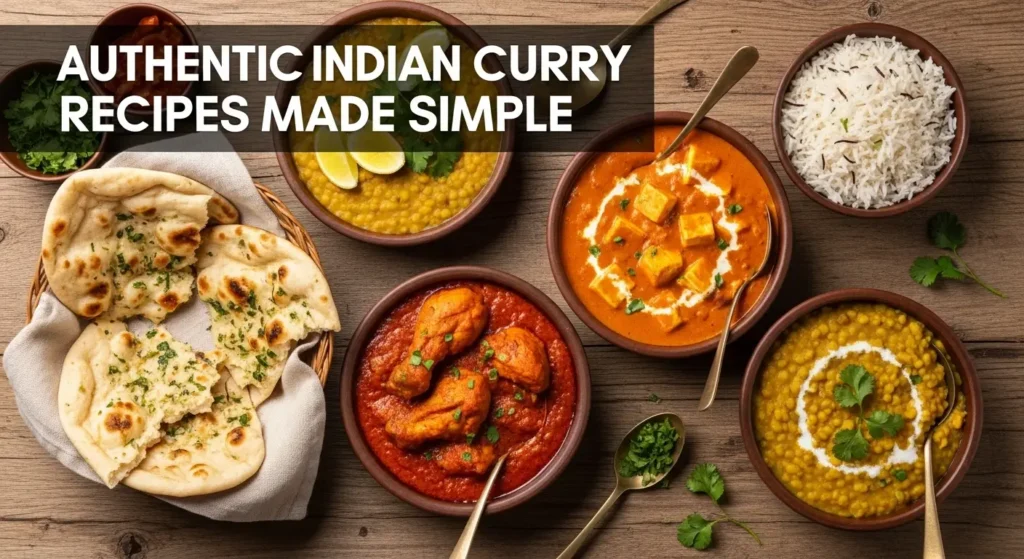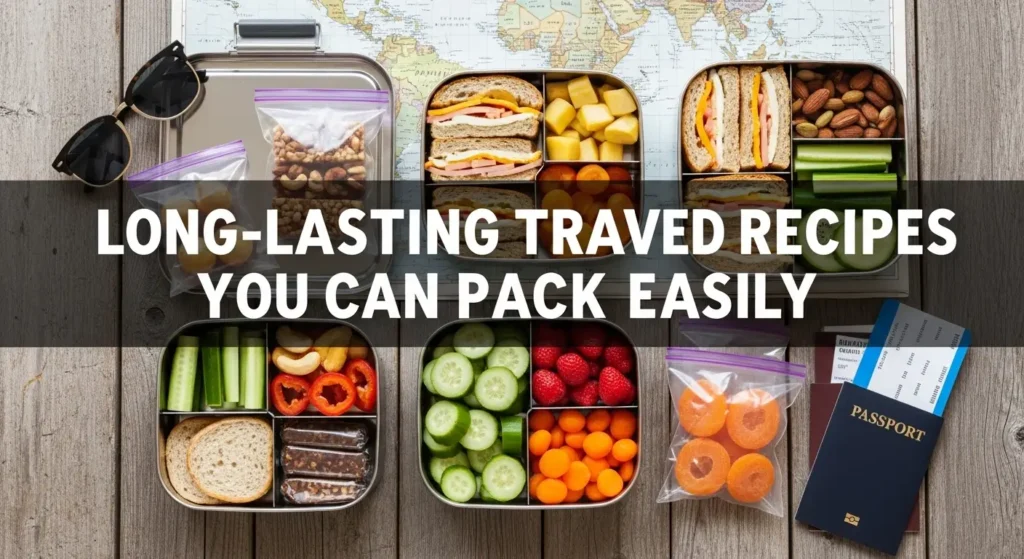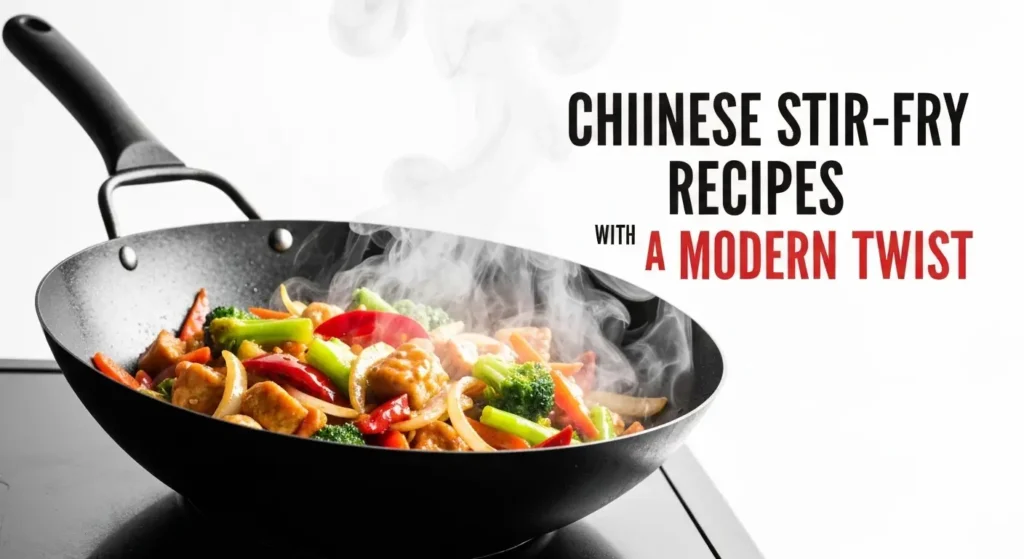There’s something magical about Thai curry—the creamy coconut base, fragrant spices, and the perfect balance of sweet, spicy, and savory flavors. Whether you’re dining out or grabbing takeout, Thai curry always feels comforting and exotic at the same time. But here’s the good news: you don’t need to wait for a restaurant visit to enjoy it. With the right techniques and ingredients, you can master Thai curry recipes that bring restaurant taste straight into your kitchen.
In this guide, we’ll explore different types of Thai curry, must-have ingredients, easy cooking tips, and recipes that anyone can follow. By the end, you’ll feel confident whipping up authentic Thai curry at home that rivals your favorite restaurant.
Understanding Thai Curry Basics
Before diving into recipes, it’s important to understand what makes Thai curry so unique. Unlike Indian curries that rely heavily on dry spices, Thai curries use fresh herbs and aromatic pastes.
Key Elements of Thai Curry
- Curry Paste: The soul of any Thai curry. Varieties include red, green, yellow, and Panang paste.
- Coconut Milk: Adds creaminess and balances the spice.
- Fresh Herbs: Thai basil, kaffir lime leaves, cilantro, and lemongrass give depth.
- Proteins & Veggies: Chicken, shrimp, tofu, eggplant, bamboo shoots, bell peppers.
- Flavor Balance: Every dish balances sweet, salty, spicy, and sour elements.
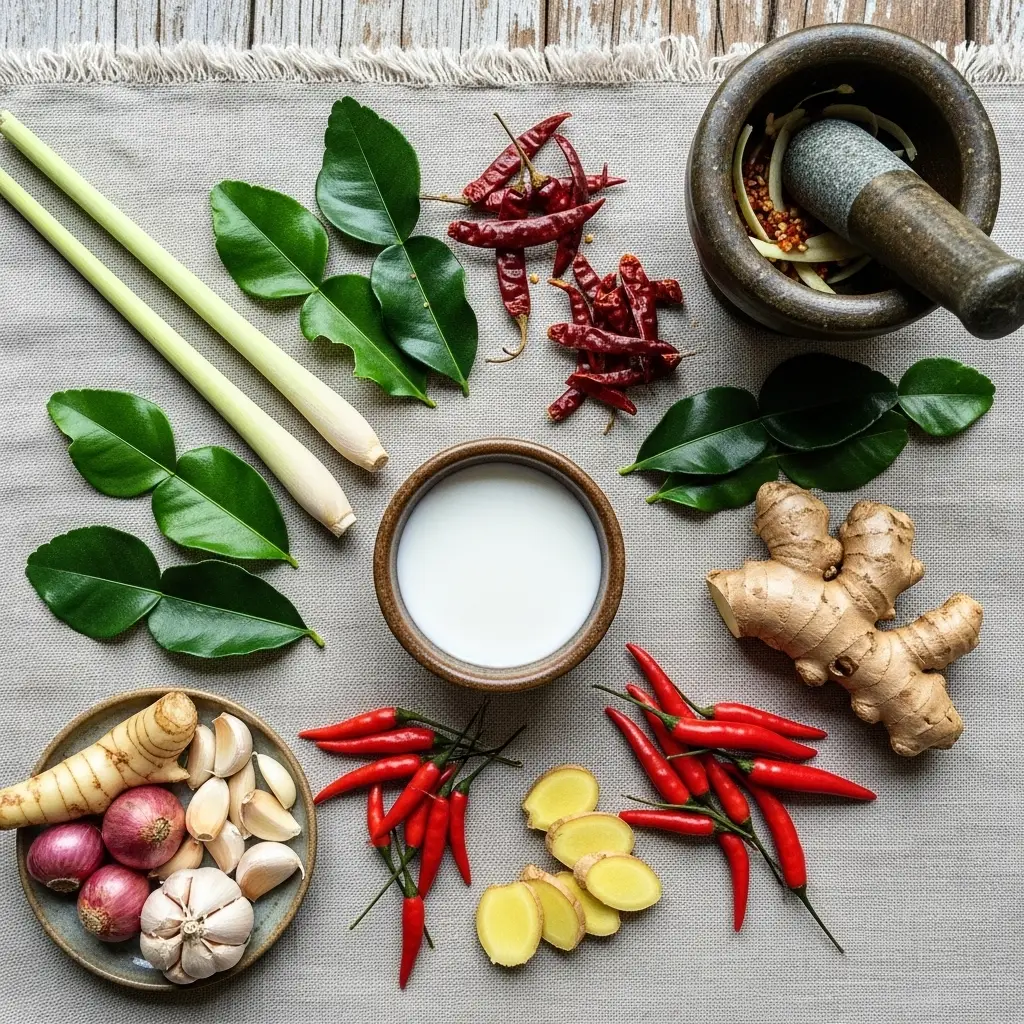
Types of Thai Curries You Should Know
Thai cuisine features several curries, each with its own flavor profile.
Red Curry (Gaeng Daeng)
Rich, spicy, and versatile. Made with dried red chilies, garlic, galangal, and shrimp paste. Perfect with chicken or beef.
Green Curry (Gaeng Keow Wan)
The spiciest curry, thanks to fresh green chilies. Balanced with coconut milk, it pairs well with seafood or eggplant.
Yellow Curry (Gaeng Karee)
Milder and sweeter, featuring turmeric and curry powder. Often served with chicken and potatoes.
Panang Curry
Creamier and less spicy, flavored with peanuts and kaffir lime leaves. Works beautifully with beef or tofu.
Also Read: Easy Mediterranean Chickpea Salad Recipes for Beginners
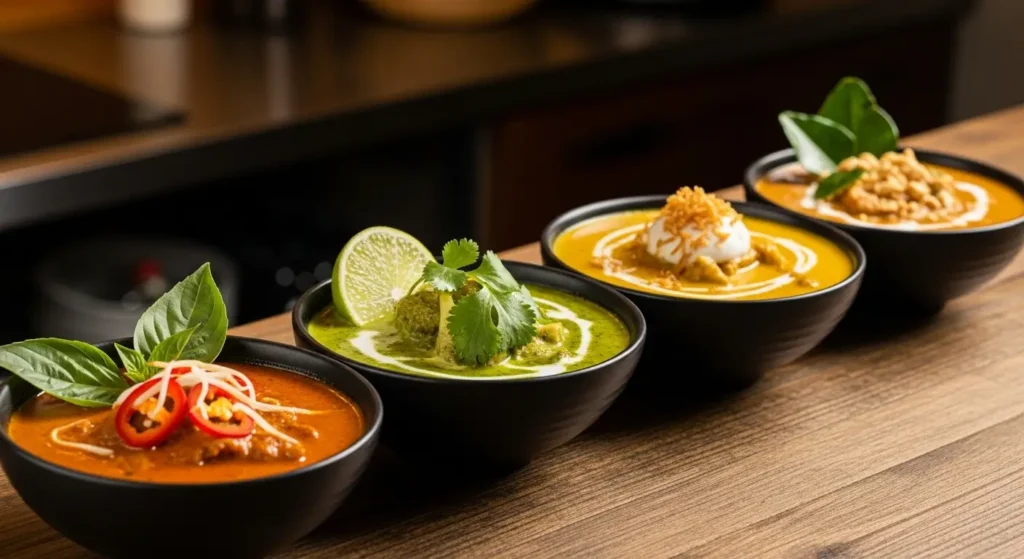
Essential Ingredients for Authentic Flavor
Cooking Thai curry at home is easier when your pantry is stocked with essentials.
Pantry Staples
- Coconut milk (unsweetened)
- Fish sauce
- Palm sugar (or brown sugar substitute)
- Curry pastes (store-bought or homemade)
- Jasmine rice
Fresh Must-Haves
- Thai basil
- Lemongrass
- Galangal (or ginger as a backup)
- Kaffir lime leaves
- Bird’s eye chilies
Pro Tip: If you can’t find everything locally, many Asian grocery stores and online shops carry authentic Thai ingredients.
Easy Thai Red Curry Recipe
Ingredients
- 2 tbsp red curry paste
- 400 ml coconut milk
- 1 lb chicken breast (sliced)
- 1 red bell pepper (sliced)
- 1 cup bamboo shoots
- 2 tbsp fish sauce
- 1 tbsp palm sugar
- Fresh Thai basil leaves
Instructions
- Heat oil in a wok, add curry paste, and sauté for 2 minutes.
- Stir in half the coconut milk and let it simmer.
- Add chicken slices and cook until tender.
- Toss in bell pepper and bamboo shoots.
- Add remaining coconut milk, fish sauce, and palm sugar.
- Simmer for 5 minutes and garnish with Thai basil.
Serving Suggestion: Pair with jasmine rice for a restaurant-style experience.
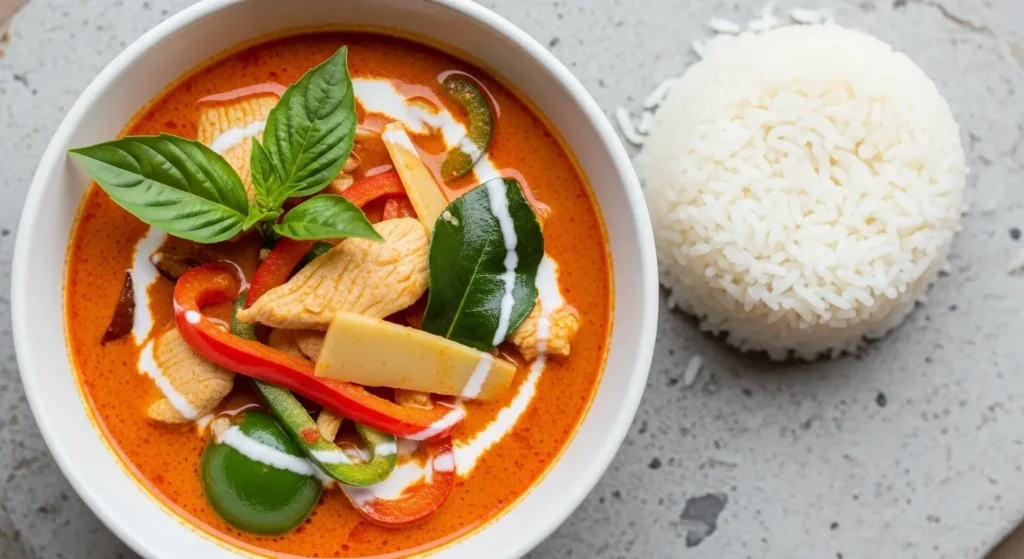
Classic Thai Green Curry with Eggplant
Ingredients
- 3 tbsp green curry paste
- 400 ml coconut milk
- 2 small Thai eggplants (quartered)
- 1 lb shrimp or chicken
- 2 kaffir lime leaves
- 2 tbsp fish sauce
- 1 tbsp sugar
- Fresh Thai basil
Method
- Heat curry paste in a wok until fragrant.
- Pour in coconut milk and bring to a boil.
- Add protein of choice and cook thoroughly.
- Stir in eggplants, kaffir lime leaves, and sugar.
- Garnish with Thai basil leaves before serving.
Note: This curry is spicier, so adjust chili levels based on preference.
Thai Yellow Curry with Chicken and Potatoes
If you prefer something milder, yellow curry is perfect.
Ingredients
- 2 tbsp yellow curry paste
- 400 ml coconut milk
- 2 medium potatoes (cubed)
- 1 lb chicken thighs
- 1 onion (sliced)
- 2 tbsp fish sauce
- 1 tbsp sugar
Steps
- Cook curry paste in a little oil.
- Add chicken and sauté until browned.
- Pour in coconut milk and bring to a boil.
- Add potatoes and onions.
- Simmer until potatoes are tender.
- Season with fish sauce and sugar.
Tip: This curry goes great with roti or naan bread for dipping.
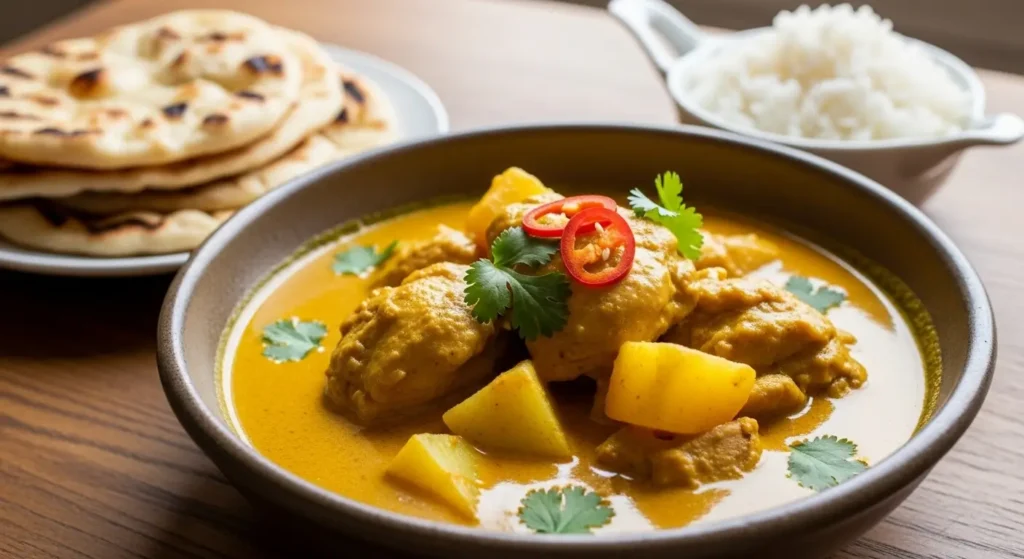
Panang Curry with Beef
Ingredients
- 2 tbsp Panang curry paste
- 400 ml coconut milk
- 1 lb beef (thinly sliced)
- 2 kaffir lime leaves (shredded)
- 2 tbsp fish sauce
- 1 tbsp palm sugar
- Crushed peanuts for garnish
Directions
- Fry Panang curry paste until aromatic.
- Add coconut milk and simmer.
- Stir in beef slices and cook until tender.
- Add kaffir lime leaves, fish sauce, and palm sugar.
- Garnish with peanuts before serving.
Serving Tip: Best enjoyed with steamed jasmine rice or sticky rice.
Tips for Cooking Thai Curry at Home
- Use high-quality coconut milk: Avoid watery ones for a creamier curry.
- Don’t skip fish sauce: It adds the umami depth.
- Balance flavors: Adjust sugar, spice, and salt as you taste.
- Cook curry paste first: This step releases all the aromatics.
- Add fresh herbs last: Basil and kaffir lime leaves should not be overcooked.
Key Takeaways
- Thai curry recipes rely on curry paste, coconut milk, and fresh herbs.
- Red, green, yellow, and Panang curries all have distinct flavors.
- Balancing sweet, spicy, sour, and salty flavors is essential.
- With simple steps, you can bring restaurant-style Thai curry home.
FAQ Section
1. Can I make Thai curry without coconut milk?
Yes, but it will lack creaminess. You can substitute with cashew cream or dairy cream, though flavor will differ.
Also Read: Easy Italian Pasta Recipes for Beginners
2. How can I reduce the spiciness of Thai curry?
Add more coconut milk, sugar, or serve with extra rice to mellow the heat.
3. Is store-bought curry paste good enough?
Absolutely. While homemade paste is fresher, good-quality brands work well for quick cooking.
4. Can I freeze Thai curry?
Yes, you can freeze cooked curry for up to 2 months. Just reheat and add fresh herbs before serving.
5. What protein works best in Thai curry?
Chicken, beef, shrimp, and tofu are most common. Each curry pairs differently, but all work well.
Conclusion
Thai curry recipes are more than just meals—they’re an experience of aroma, flavor, and tradition. With a few key ingredients and techniques, you can recreate restaurant-quality curries in your own kitchen. From the fiery green curry to the creamy Panang, every dish brings you closer to the vibrant flavors of Thailand.
So next time you crave comfort food, skip the takeout menu and try making Thai curry at home. You’ll be surprised at how easy, fun, and rewarding it is.

